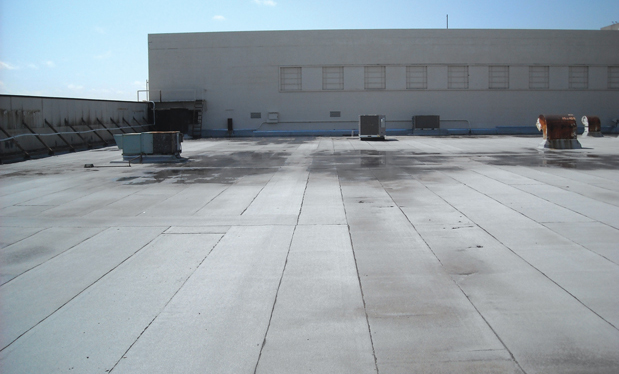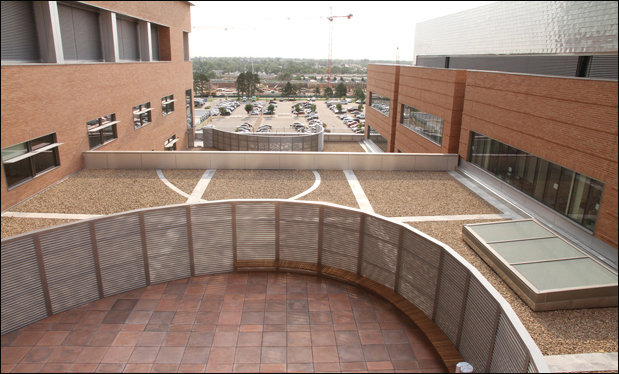For several years, NRCA has been awarded a Susan Harwood grant from the Occupational Safety and Health Administration (OSHA) to develop and deliver a full-day fall-protection training class for roofing workers at various locations throughout the U.S. The class focuses on fall hazards common in roofing and fall-protection systems and controls to minimize or eliminate these hazards.
One question NRCA instructors often ask during the class is: "Would your choice of a fall-protection system or systems be different depending on the type of roof system being installed?" The answer expressed is almost universally "no." However, most attendees usually agree each roof system installation presents unique challenges for effective fall-protection implementation. This may be especially evident with the use of warning-line and safety-monitoring systems, in particular when single-ply roof systems are being installed.
The rules
According to OSHA rules, roofing workers on low-slope roofs (4:12 or less) must be protected from falls at heights of 6 feet or greater by guardrail, safety net or personal fall-arrest systems—commonly referred to as "conventional" fall-protection systems. Conventional fall-protection systems are required to protect other construction workers covered under OSHA regulations, as well. In 1980, after initially failing to distinguish roofing work from other work when requiring fall-protection systems, OSHA provided additional fall-protection options for roofing work. The agency finally acknowledged conventional systems cannot always be implemented for roofing work.
Some reasons for this determination include the following: anchor points are unavailable or impede roof system installation and damage the integrity of waterproofing membranes; guardrails demand constant removal or relocation, exposing workers to increased fall hazards; and lifelines cause trip and slip hazards in addition to being rendered inoperable by asphalt or adhesives. It could be argued no other trade under the original rules was obliged to damage their finished work product to implement conventional fall protection.
A unique provision applicable to workers performing roofing work on low-slope roofs allows for a warning-line system in combination with one of the conventional fall-protection systems or a warning-line and safety-monitoring system to be used to protect roofing workers. Warning lines are designed to contain a work area inside which roofing work may take place without conventional fall protection. When workers go outside the contained area, conventional fall protection or a safety monitor must be used to protect those workers. On roofs 50 feet wide or less, a safety-monitoring system alone may be used.
But before roofing contractors can take advantage of warning-line or safety-monitoring systems, the work being done must fall within the definition of "roofing work." OSHA defines roofing work as "… the hoisting, storage, application, and removal of roofing materials and equipment, including related insulation, sheet metal, and vapor barrier work, but not including the construction of the roof deck."
If work taking place on a low-slope roof does not fall within the definition of roofing work, only conventional fall protection may be used to protect workers at heights 6 feet or greater.
Single plies
Additional restrictions on the implementation of the warning-line and safety-monitoring systems can be challenging when installing single-ply roof systems. OSHA rules prohibit the use or storage of mechanical equipment in areas where roofing workers are being protected by a safety-monitoring system. Mechanical equipment only may be used in areas where workers are protected by a warning-line system, guardrails or a personal fall-arrest (PFA) system. OSHA defines mechanical equipment as human- or motor-propelled wheeled equipment used for roofing work but not wheelbarrows or mopcarts.
In a letter of interpretation from 2000, OSHA also stated heat welding guns, screw guns and mop carts, among other tools, are not mechanical equipment under the warning-line and safety-monitoring rules.
The OSHA letter did not specifically address robotic welders, but the agency said generally equipment that must be wheeled and maneuvered into position and monitored is more likely to have its use restricted as mechanical equipment. Ordinarily, this would require a worker operating such equipment outside warning lines to use a PFA system and no other workers could be outside the warning lines if monitored by a safety monitor. Such workers also would require PFA systems for fall protection when mechanical equipment was being used outside warning lines.
Single-ply roof membranes commonly range between 8 to 12 feet in width. Such significant widths may result in challenges for warning-line or guardrail setup and relocation as work progresses. This particularly is problematic when heavy guardrail baseplates and railings must be moved substantially away from the roof edge to allow for unrolling a membrane and then repositioned after the sheet is in place and adhered or attached.
Warning-line stanchions pose similar difficulties because of the cumbersome nature of the flagged line and stanchions (though the stanchion weight generally is less of an issue). Movement and repositioning the fall-protection equipment to install the membrane must be well choreographed by crew leaders to keep workers safe from trips and falls.
Available options
Some innovative equipment may prove valuable when offering worker protection while allowing for more efficient roof membrane installation.
Photo 1 shows a parapet wall clamping system made by Acro Building Systems with an integrated guardrail post for securing 2- by 4-inch wooden toprails and midrails. Photo 2 shows a similar product, Fixfast USA's Turbo-Rail System, and Photo 3 shows Guardian's Alligator Parapet Roof System. Other manufacturers offer similar products, such as Miller's EPIC Barrier System, Safety Rail Company's SRC Parapet Clamp, Perimeter Protection Products' Parapet Wall Clamp, Capital Safety's Portable Construction Guardrail and the AES Raptor RaptorRail.™
The advantage of using these components is the fall-protection equipment is installed so field membrane installation can proceed unimpeded without the need to move stanchions, base plates or siderails.
Not all buildings have convenient parapet walls for attaching the securing clamps that provide the foundation for all these systems. Other equipment is designed to allow for installation of support brackets for posts with minimal intrusion into the roofing work area.
Photo 4 shows Garlock's TurboCable Fall Protection System, which attaches to different types of roof edges or parapet walls to provide perimeter protection. The manufacturers mentioned earlier also produce specialized brackets for installation of their guardrail systems on exterior walls as well for unrestricted access to the roof surface. The systems often use the identical guardrail posts or alternate components that incorporate steel cable instead of wooden rails. The cable can be tensioned to maintain the required guardrail height between 39 to 45 inches and the strength requirement to withstand 200 pounds of force applied to the toprail in a downward or outward direction. In addition, the cable must be flagged at minimum 6-foot intervals to comply with OSHA rules.
Additional methods that provide complete protection while allowing for unrestricted access to the entire roof area include safety nets, such as the one shown in Photo 5 from Incord Custom Safety Netting Solutions, and scaffolding, which essentially acts as a form of guardrail system, as shown in Photo 6.
Safety solutions
Many fall-protection equipment manufacturers also provide services related to custom solutions that are designed for unique structures or applications. I encourage you to contact manufacturers' representatives to assist with projects that may require a more engineered approach to the special fall-protection challenges presented. A comprehensive solution then can be tailored that accounts for building design elements, roof system materials and installation procedures, and other critical factors unique to the project.
For a majority of roofing projects, including single-ply membrane installations, the fall-protection equipment described may have a positive effect on production while achieving OSHA regulatory compliance. These specialized products appropriately are categorized as conventional fall-protection systems, which often are specified by some general contractors and business owners.
However, the longevity of warning-line and safety-monitoring systems in the roofing industry is a testament to their effectiveness and ease of use for providing worker protection and system setup and adjustment during system installation. As with all fall-protection systems, regardless of their features and installation methods, successful implementation demands constant management and equipment oversight to ensure worker safety.
Harry Dietz is NRCA's director of risk management.



